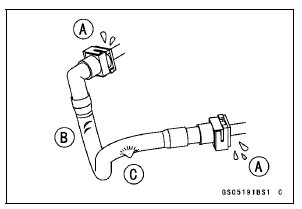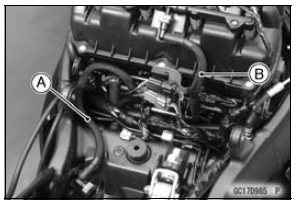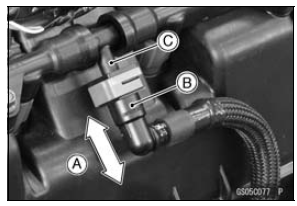

Replace the fuel hose if any fraying, cracks [B] or bulges [C] are noticed.

Replace the hose if it has been sharply bent or kinked.

Push and pull [A] the fuel hose joint [B] back and forth more than two times, and make sure it is locked.
Check the other hose joint in the same way.

NOTICE
When pushing and pulling the fuel hose joint, do not apply strong force to the delivery pipe [C] on the nozzle assy. The pipe made from resin could be damaged.
| WARNING Leaking fuel can cause a fire or explosion resulting in serious burns. Make sure the hose joint is installed correctly on the delivery pipe by sliding the joint. |
If it does not locked, reinstall the hose joint.
 Idle Speed Inspection
Idle Speed Inspection Evaporative Emission Control System Inspection (CAL and SEA-B1 Models)
Evaporative Emission Control System Inspection (CAL and SEA-B1 Models)Valve Removal
Remove the cylinder head (see Cylinder Head Removal).
Remove the valve lifter and shim.
Mark and record the valve lifter and shim locations so they
can be installed in their original positions.
Using the valve spring compressor assembly, remove the
valve.
Special Tools - Valve ...
Tire Installation
WARNINGSome replacement tires may adversely
affect handling
and cause an accident resulting in serious injury
or death. To ensure proper handling and stability,
use only the recommended standard tires for
replacement, inflated to the standard pressure.
Inspect the rim ...
Alternator Inspection
There are three types of alternator failures: short, open
(wire burned out), or loss in rotor magnetism. A short or
open in one of the coil wires will result in either a low output,
or no output at all. A loss in rotor magnetism, which may be
caused by dropping or hitting the alternator, by leav ...